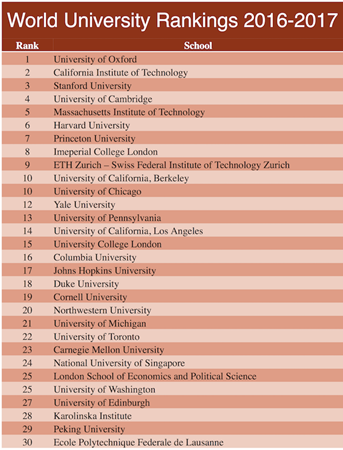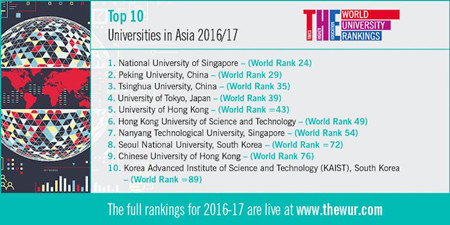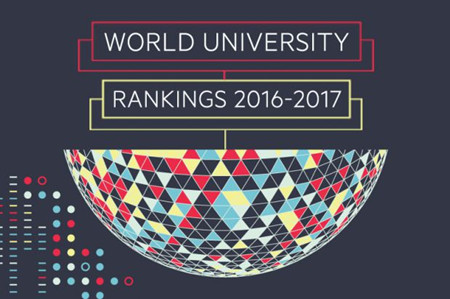In September 2016, Times Higher Education (THE) released its World University Rankings 2016-2017. As one of China’s flagship universities, Peking University improved its position –– currently at 29th in the world compared with 42nd last year. Founded in 1898, Peking University was originally known as the Imperial University of Peking. It was the first national university covering comprehensive disciplines in China, and has been a leading institution of higher education in China since its establishment.
Peking University joins the top 30, in 29th place (up from 42nd last year)
The University of Oxford took the top spot, knocking back the five-time leader, the California Institute of Technology, into second place. The University of Oxford has become the first UK University to top the Times Higher Education World University Rankings in the 12-year history of the table.

Times Higher Education World University Rankings 2016/17 (Top 30)
However, while these Western countries continue to dominate the upper echelons of the ranking, Asia is becoming increasingly visible, with several of the continent’s institutions edging closer to the top 20. There is a notable rise of Asian universities taking the top spots in the THE rankings.
 Times Higher Education Top 10 Universities in Asia 2016/17
Times Higher Education Top 10 Universities in Asia 2016/17
Mainland China takes four places in the top 200, up from two last year, with its leader Peking University joining the top 30, in 29th place (up from 42nd last year), and its regional rival Tsinghua University making its debut in the top 40, in 35th place (up from joint 47th). China’s rise can be partly attributed to its improved scores in the academic reputation survey, which underpins both the research and teaching indicators in the methodology. The country’s institutions have also improved their scores for citations and internationalization.
A total of 289 Asian universities from 24 countries are on the list and an elite group of 19 are in the top 200, up from 15 last year. When analyzing which countries achieve the highest average scores, Singapore comes top on all five of the pillars underlying the ranking – teaching, research, citations, industry income and international outlook. Hong Kong is second for teaching, third for research and fourth for citations.
Rajika Bhandari, deputy vice-president of research and evaluation at the Institute of International Education and co-editor of the book Asia:
The Next Higher Education Superpower?, said that the “sharp rise” of Asia’s universities is due to three main factors: rapidly growing populations and demand for higher education in the region; governments making “significant investments” in universities; and improvements by individual institutions.
She predicted that there will be continued expansion of cross-degree and campus partnerships among institutions in Asia and the West, as well as a “huge push towards intra-regional higher education partnerships and mobility within the Asia-Pacific region”.On advances at university level, she said that many Asian scholars who studied at Western universities are now academics in their home countries and have “really begun to transform their own higher education sectors”.
Francisco Marmolejo, the World Bank’s lead tertiary education specialist, says that the East Asian region has made “remarkable progress” in terms of access to and the quality of higher education. He cites the growth of private funds to universities as one of the main factors contributing to the rise of China and Hong Kong.
Will an Asian university reach the top 10 of the rankings in the near future?
Marmolejo says that there is no doubt that this will happen, but adds: “How fast and who will arrive first? Nobody can predict that.”
From Times Higher Education
By Ellie Bothwell


















